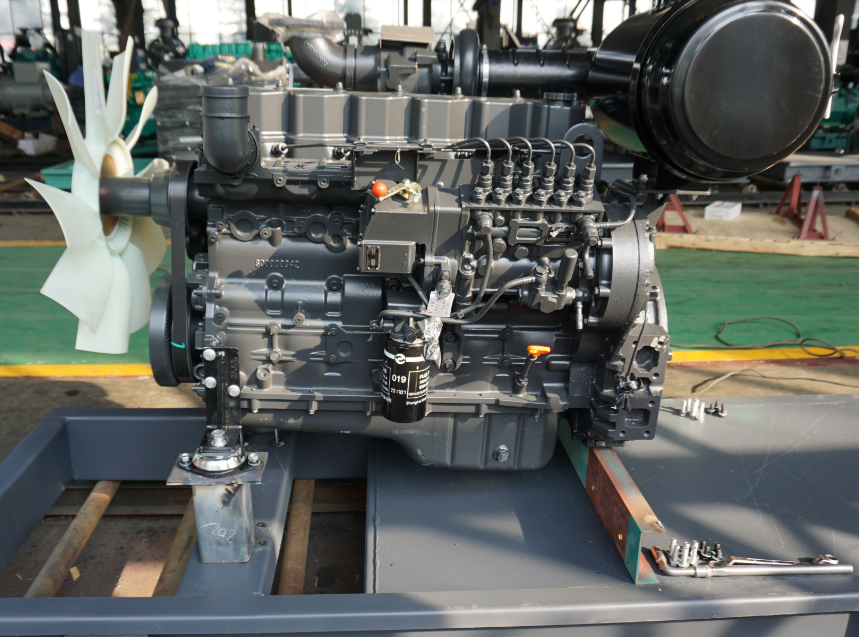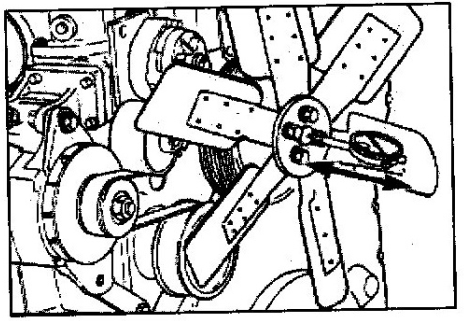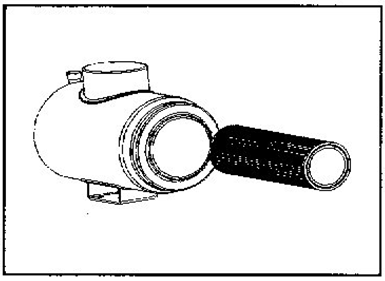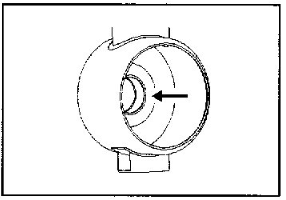Adjusting diesel engine is very important for engine maintenance and operation. In this section, we will learn the details of adjusting Shangchai SC27G series diesel engine. The main parts include checking and adjusting valve clearance, checking inter-cooler and its lines, fan bearing , turbocharger, vibration damper, changing coolant and cleaning system and repairing air filter element.

When doing the first maintenance for a new or overhauled engine, conduct valve-clearance checking to timely regulate and correct the initial changes of the valve clearances. Later valve clearance checking and regulating should be done based on the maintenance plan if the engine operates normally.
Valve clearance checking should be conducted after the engine has been stopped and the coolant temperature falls to below 60℃.
(1) Remove the nut on the valve cover and scrap the cover and scrap the seals and gaskets
(2) Rotate the engine and make the piston of No. 1 cylinder position at the top dead center on the compression stroke.
Note: When the indicator 11 0n the flywheel housing points at mark o in the flywheel viewed from the observing window on the flywheel housing plate 9, the piston of N0 1 0r No. 6 cylinder is at the top dead center.
(3) Check if the rocker arms of No.l cylinder are loose. If they are loose, the piston of No. 1 cylinder is at the top dead center on compression stroke; if not. the piston of No. 6 cylinder is at the top dead center on compression stroke.
(4) When the piston of No.l cylinder is at the TDC on compression stroke, check with a feeler gauge the intake valve clearances of No. 1, 2, 4, 9, 11 and 12 cylinders, as well as the exhaust valve clearances of No.l, 3, 5, 8, 9 and 12 cylinders; when the piston of No.6 cylinder is at the TDC an compression stroke, check with a feeler gauge the intake valve clearances of No. 3, 5, 6, 7, 8 and 10 cylinders, as well as the exhaust valve clearances of No. 2, 4, 6, 7, 10 and 11 cylinders;
Note: The clearance is correct when some resistance is felt at which the feeler gauge is slipped between a valve stem and a rocker arm.
(5) If a valve clearance fails to meet the requirement, loosen the adjusting screw locknut on the corresponding rocker arm, adjust the clearance to the specified value and tighten the locknut t0 50 - 60 N-m. Check the valve clearance again and it should not change.
Valve clearance:
0.30 - 0.35 mm
0.35 - 0.40 mm
(6) Mark a sign on the damper and rotate the crankshaft for a circle (360 degrees). Follow the same steps to adjust the rest intake and exhaust valve clearances.
(7) Install the valve cover with new seals and gaskets and tighten the cover nuts t0 10-15 N-m.
Perform visual check on the air inlet and outlet chambers of the intercooler for crack, perforation or other damages, and on the air inlet and outlet pipes of the intercooler for sealing-off and other damages. Replace the intercooler if necessary.
Perform visual check on the hoses of the air inlet and outlet pipes for crack, and check clamps for looseness. Replace the hose(s) if any fault is found, and tighten clamp screws if looseness is found.

Remove the drive belt. Turn the fan to check the fan bearing for normality. When rotating the fan, there should be no vibration or excessive axial or/and radial movement. Replace the fan hub if
necessary.
Perform visual check on the impeller blades of the turbine and compressor of the turbocharger for damage, crack, or contact with their housings when a light finger pressure applied on them. And check the turbocharger shaft for not being free spinning. In case that any of the above problems occur, the turbocharger should be replaced.
Check the vibration damper for damping fluid (silicon fluid) leak and surface dents. Also examine the thickness of damper to confirm if the damper has become deformed. In case that any of the above problems occur, the damper should be replaced.
In order to ensure the engine coolant to be good in cooling and anti corrosion, the replacement of coolant and cleaning of cooling system are required every 2,000 hours or 2 years, whichever comes first.
Warning: At operating temperature, engine coolant is hot and under pressure, and coolant steam can cause personal injury. Do not remover the pressure cap on the radiator until the engine stops and coolant temperature goes below 50'C. Slowly unscrew the pressure cap to release the cooling system pressure.
Warning: The anti rust additive in the coolant contains alkali. Avoid skin and eye contact with it to prevent personal injury.
(1) Stop the engine and wait until the temperature of the coolant falls to below 50'C. Slowly unscrew the pressure cap to release the cooling system pressure and remove the cap. Loosen the drain cock of the radiator to completely drain the coolant in the radiator.
(2) Loosen the drain cocks of the oil coolers (one on each engine side), remove the water drain plugs of the water pumps (one on each engine side) to drain the coolant in the engine cooling system.
(3) Clean the cooling system according to the following steps.
(a) Install and screw up all the drain cocks and plugs, and add the sodium carbonate solution (or the mixture of sodium carbonate and water that is available in market) into the cooling system from the coolant filler.
Caution: Each 23 L of water should be mixed with 0.5 kg sodium carbonate. Do not use caustic cleaner, or it will do harm to aluminum parts.
Purge the air in the coolant system while adding the cleaning fluid. Pour the cleaning fluid slowly to avoid air block. The cleaning fluid should be added up to the bottom of the filter in the radiator and wait for about 3-5 minutes for a full purge of air.
(b) Start the engine and keep it running for 5 minutes after the cleaning fluid temperature has gone up to above 80℃, then stop the engine and completely drain the cleaning fluid in the cooling system.
Caution: During the whole cleaning process the pressure cap should not be on and the engine runs without the cap on.
(c) Add clean water into the cooling system
Caution: Pour clean water slowly to avoid air block. Clean water should be added up to the bottom of the filler in the radiator and wait for about 3-5 minutes for a full purge of air.
(d) Start the engine and keep it running for 5 minutes after the water temperature has gone up to above 80'C, then stop the engine and completely drain the clean water in the cooling system.
Caution: If the discharged water is still dirty, clean the cooling system again according to the aforesaid steps until discharged water becomes clean.
(4) After the cleaning, tighten the water drain cock of the radiator, and the drain cocks of the oil coolers. Apply sealant
Tonsan 1567F to the thread of the drain plugs of the water pumps and tighten them t0 60-80 N-m.
(5) Add coolant. Fill the cooling system with proper coolant. The total coolant capacity is about 151 1.
Caution: The actual amount of coolant should refer to the equipment data.
Caution: Add coolant slowly to avoid air block. Coolant should be added up to the bottom of the filler in the radiator or meet the requirement of the equipment manufacturer. Wait for about 3-5 minutes for a full purge of air.
(6) Install the pressure cap on the radiator, start and run the engine until coolant temperature reaches 80'C, then stop the engine and check the cooling system for leakage.
{7) Stop the engine and wait until the coolant temperature falls to below 50'C. Then open the pressure cap and recheck the coolant level. Supplement properly, if necessary.

(1)Blow off dirt on the filter with pressured air.
(2)Remove the filter cover, remove and scrap the element.
Cover the compressor inlet from inside the air filter body with clean stuff to prevent dirt from entering the intake system.

Clean the inside of the filter body. Check the new filter element for any defects and remove the covering stuff from the compressor inlet. Install the new element and make sure a sound seal at both ends. Install the air filter cover and the
service indicator.
Caution: Be sure that both end faces of the air filter are reliably sealed without leakage after the air filter element has been changed.
For the information about Shangchai G series diesel engine operation and maintenance, please visit:
Shangchai G Series Diesel Engine Operation And Maintenance Manual
Shangchai G Series Engine Nameplate And Specifications
SC27G Diesel Engine installation and Connection
SC27G Diesel Engine Operation And Engine Start
SC27G Diesel Engine Maintenance Instructions
SC27G Diesel Engine Maintenance
Copyright © Guangxi Dingbo Generator Set Manufacturing Co., Ltd. All Rights Reserved | Sitemap
Update cookies preferences